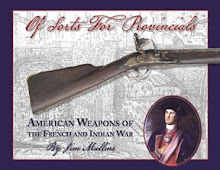In the Pension Application of Simeon Buford he mentions that he "wore a Belt to carry his hatchett, which had a brass buckle on it, which had inscribed on it “21 Regiment.”
Thankfully, some people in the period did use a cover so those who feel compelled to use one have something to go on.
from Knox, John D. (Doughty, Arthur G. Ed.) An historical journal of the campaigns in North America for the years 1757, 1758 and 1760 Volumes I-III, Toronto Canada, Champlain Society, 1914-1916
p352 1759
"His knapsack is carried very high between his shoulders, and is fastened with a strap of web over his shoulder, as the Indians carry their pack. His cartouch-box hangs under his arm on the left side, slung with a leathern strap; and his horn under the other arm on the right, hanging by a narrower web than that used for his knapsack; his canteen down his back, under his knapsack, and covered with cloth; he has a rough case for his tomahock, with a button; and it hangs in a leather sling down his side, like a hanger, between his coat and waistcoat."
As the images below will show, there are several forms and ways of doing these in the 18th and early 19th centuries.
Isaac Shelby's hatchet and cover:
Alexander MacKenzie
1767 Huntsman's rig
Farrier, 11th Dragoons by Morier ca 1750
German Military ca 1783 from "Was ist oficier..." (for originals see Burg Forchtestine):
and a French example from La Porterie ca 1754:
Arthur Wentworth of Bulmer, near Castle Howard, Yorkshire 1767


